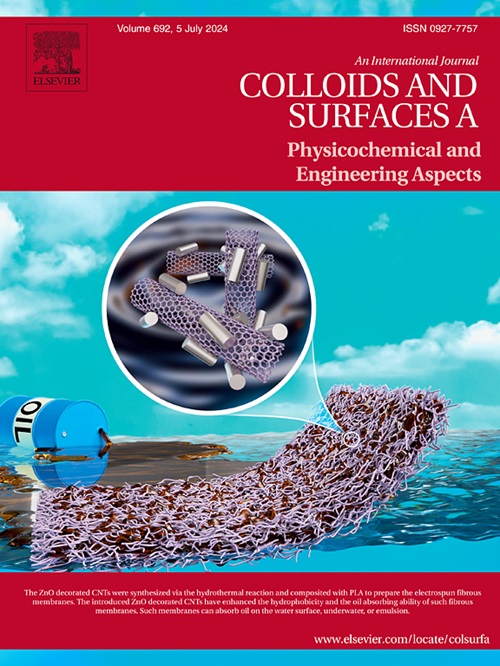Surfactant molecules and nano gold on HOPG: Experiment and theory
IF 4.9
2区 化学
Q2 CHEMISTRY, PHYSICAL
Colloids and Surfaces A: Physicochemical and Engineering Aspects
Pub Date : 2024-11-08
DOI:10.1016/j.colsurfa.2024.135664
引用次数: 0
Abstract
Excessive surfactant molecules within the solution adhere to highly ordered pyrolytic graphite (HOPG) when a droplet containing gold nanorods evaporates, leading to the emergence of a unique coffee-ring pattern. The combination of surface hydrophobicity and evaporation of the aqueous phase results in a stick-slip motion, which enhances the convective hydrodynamics of suspended particles. This phenomenon initiates interactions that influence the deposition and flow dynamics inside the droplet. High-resolution scanning electron microscopy (HRSEM) does not provide significant insights into regions potentially linked to cetyltrimethylammonium bromide (CTAB) molecules, whereas the atomic force microscope (AFM) displays the presence of gold nanoparticles arranged by CTAB within specific CTAB patches. The layers forms with varying heights and gaps between them, indicating diverse adhesion of CTAB. The analytical focus lies on the quantitative assessment of CTAB molecules, stripe dimensions, and energy profiles influenced by concentration and the effective positioning of CTAB-coated gold nanorods in CTAB-covered regions. AFM examination reveals CTAB molecular stripes on HOPG, showing a binding energy of −20 kJ/mol with the surface, −10 kJ/mol for nitrogen bonding with HOPG, and a total binding energy (BE) of −60 kJ/mol, considering various contributing factors. Completely parallel aligned molecules (CPAM) exhibit higher binding energy than non-perfectly aligned molecules (NPAM) due to maximum Van der Waals (VdW) interactions, ideal electrostatic interactions, and minimal steric repulsion. The difference in binding energy between perfectly and non-perfectly aligned molecules is around 20kJ/mol, emphasizing the importance of molecular orientation. As temperature rises from 298 K to 348 K, the likelihood of NPAM desorption increases significantly, with the binding energy shifting from 2.5kJ/mol to 4.1kJ/mol. Temperature significantly influences the equilibrium of molecules on HOPG surfaces. The emphasis is on elucidating the alterations in energy levels during nanorod aggregation on CTAB areas compared to bare HOPG surfaces, underscoring the impact of nanorods on CTAB micelle deformation energy. Observations on the variation in CTAB desorption rates with temperature changes underscore the dynamic nature of molecular binding energy associated with surface properties, underscoring the importance of molecular configuration and energy transfers in nanoscale systems.
HOPG 上的表面活性剂分子和纳米金:实验与理论
当含有金纳米棒的液滴蒸发时,溶液中过量的表面活性剂分子会附着在高有序热解石墨(HOPG)上,从而形成独特的咖啡环图案。表面疏水性与水相蒸发的结合产生了粘滑运动,从而增强了悬浮颗粒的对流流体力学。这种现象引发的相互作用影响了液滴内部的沉积和流动动力学。高分辨率扫描电子显微镜(HRSEM)无法深入了解可能与十六烷基三甲基溴化铵(CTAB)分子相关联的区域,而原子力显微镜(AFM)则显示在特定的 CTAB 斑块内存在由 CTAB 排列的金纳米颗粒。这些层的高度和间隙各不相同,表明 CTAB 的粘附性多种多样。分析重点在于定量评估 CTAB 分子、条纹尺寸、受浓度影响的能量曲线以及 CTAB 镀金纳米棒在 CTAB 覆盖区域的有效定位。原子力显微镜检查显示,HOPG 上的 CTAB 分子条纹与表面的结合能为 -20 kJ/mol,与 HOPG 的氮键结合能为 -10 kJ/mol,考虑到各种因素,总结合能 (BE) 为 -60 kJ/mol。完全平行排列分子(CPAM)的结合能高于非完全排列分子(NPAM),这是由于范德华(VdW)相互作用、理想的静电相互作用和最小的立体排斥作用达到了最大值。完全排列和非完全排列分子之间的结合能相差约 20kJ/mol,这强调了分子取向的重要性。当温度从 298 K 上升到 348 K 时,NPAM 解吸的可能性显著增加,结合能从 2.5kJ/mol 上升到 4.1kJ/mol。温度对 HOPG 表面的分子平衡影响很大。重点是阐明与裸 HOPG 表面相比,纳米棒在 CTAB 区域聚集时的能级变化,强调纳米棒对 CTAB 胶束变形能的影响。对 CTAB 解吸率随温度变化而变化的观察强调了与表面特性相关的分子结合能的动态性质,突出了纳米级系统中分子构型和能量转移的重要性。
本文章由计算机程序翻译,如有差异,请以英文原文为准。
求助全文
约1分钟内获得全文
求助全文
来源期刊
CiteScore
8.70
自引率
9.60%
发文量
2421
审稿时长
56 days
期刊介绍:
Colloids and Surfaces A: Physicochemical and Engineering Aspects is an international journal devoted to the science underlying applications of colloids and interfacial phenomena.
The journal aims at publishing high quality research papers featuring new materials or new insights into the role of colloid and interface science in (for example) food, energy, minerals processing, pharmaceuticals or the environment.

 求助内容:
求助内容: 应助结果提醒方式:
应助结果提醒方式:


